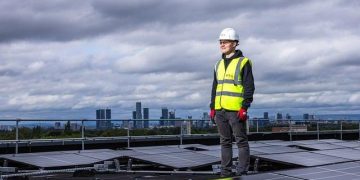In an era where the sun’s golden embrace powers our homes and fuels our dreams of a sustainable future, the solar industry stands as a beacon of innovation and progress. Yet, beneath the shimmering panels and cutting-edge technology lies a challenge that demands attention: equipping the workforce with the skills necessary to harness this renewable energy. Enter the world of Virtual Reality (VR) tools, a technological marvel that is transforming the way we train and prepare solar industry professionals. With the ability to create immersive, realistic simulations, VR is revolutionizing workforce training, offering a dynamic and engaging approach that transcends traditional methods. This article explores how VR tools are reshaping the landscape of solar industry training, providing a glimpse into a future where learning is as vibrant and powerful as the energy we seek to capture.
Immersive Learning Environments Revolutionizing Solar Industry Training
As the solar industry continues to expand, the demand for skilled professionals is surging. Immersive learning environments are at the forefront of transforming how solar industry training is delivered, offering a dynamic and interactive approach that traditional methods lack. Virtual Reality (VR) tools provide an engaging platform for trainees to simulate real-world scenarios without the inherent risks and costs. Trainees can practice installation, maintenance, and troubleshooting of solar panels in a virtual setting, gaining hands-on experience in a safe environment.
Some of the key benefits of using VR tools in solar industry training include:
- Enhanced Learning Experience: VR allows learners to visualize complex concepts and interact with 3D models, making learning more intuitive.
- Risk-Free Environment: Trainees can make mistakes and learn from them without the fear of causing damage or incurring costs.
- Remote Accessibility: Training can be accessed from anywhere, making it ideal for geographically dispersed teams.
- Cost-Effective: Reduces the need for physical materials and onsite trainers, cutting down training expenses.

Harnessing VR Technology to Enhance Workforce Skills and Safety
Incorporating virtual reality into the training programs of the solar industry presents an innovative approach to building a more skilled and safety-conscious workforce. VR tools can simulate realistic, hands-on experiences without the risks associated with on-site training. By providing a controlled environment, trainees can engage in tasks such as solar panel installation and maintenance, gaining valuable insights and muscle memory before they ever set foot on a rooftop. This immersive method allows for the exploration of various scenarios, including emergency situations, ensuring that workers are well-prepared for any challenge they may face.
- Enhanced Learning Experience: VR creates an interactive platform where trainees can practice repeatedly until they master each skill.
- Safety First: By experiencing potentially dangerous situations in a virtual space, workers learn to prioritize safety without real-world consequences.
- Cost-Effective Training: Reducing the need for physical materials and resources, VR can lower training costs significantly while increasing efficiency.
- Adaptability: Training modules can be easily updated to reflect the latest industry standards and technological advancements.

Innovative VR Solutions Tailored for Solar Sector Professionals
In the ever-evolving solar industry, cutting-edge VR tools are transforming workforce training by offering immersive experiences that mimic real-world scenarios. These virtual environments enable solar professionals to gain hands-on experience without the risks associated with live installations. Through VR, trainees can explore a range of complex scenarios, from navigating rooftop solar installations to troubleshooting photovoltaic systems, all within a controlled and safe virtual setting.
- Realistic Simulations: Engage with lifelike simulations that replicate the challenges faced on the field.
- Cost-Effective Training: Reduce the expenses associated with traditional training methods by eliminating the need for physical materials and travel.
- Enhanced Safety: Minimize the risk of accidents and injuries by practicing in a risk-free environment.
- Personalized Learning: Tailor training modules to meet the specific needs and skill levels of individual professionals.
By leveraging VR technology, the solar sector is not only enhancing its training methodologies but also paving the way for a more skilled and adaptable workforce. As these tools continue to evolve, they promise to revolutionize how solar professionals are prepared to meet the industry’s dynamic demands.

Best Practices for Integrating VR Tools into Solar Industry Training Programs
Incorporating virtual reality into training programs within the solar industry requires a strategic approach to ensure effectiveness and engagement. Begin by identifying specific training objectives that VR can address, such as safety protocols or installation techniques. This ensures that the technology enhances learning rather than serving as a novelty. Collaborate with VR developers who have experience in the solar sector to tailor content that meets industry standards and regulations.
Key considerations for successful integration include:
- Accessibility: Ensure VR tools are user-friendly and accessible to all trainees, including those with disabilities.
- Feedback Mechanisms: Implement real-time feedback systems within the VR environment to help trainees understand and correct mistakes immediately.
- Scalability: Choose VR solutions that can be easily scaled to accommodate growing training needs and updates in solar technology.
- Assessment and Evaluation: Develop metrics to assess the effectiveness of VR training modules and their impact on trainees’ performance.
By focusing on these best practices, solar industry training programs can leverage VR to create immersive and effective learning experiences that equip the workforce with the necessary skills and knowledge.
To Wrap It Up
As the sun sets on our exploration of VR tools revolutionizing the solar industry workforce, it becomes evident that this innovative technology is more than just a passing trend. It is a powerful ally in the quest for cleaner energy and a more skilled workforce. By immersing trainees in realistic scenarios without the constraints of time, space, or resources, VR is bridging the gap between theory and practice, preparing them for the challenges of tomorrow. As we look to the horizon, the potential of VR in transforming solar industry training is as boundless as the energy it seeks to harness. Whether you are an industry veteran or a newcomer eager to learn, the dawn of VR-enhanced training promises a brighter, more efficient future. With each virtual lesson, we are not just building skills; we are constructing the very foundation of a sustainable world.

































